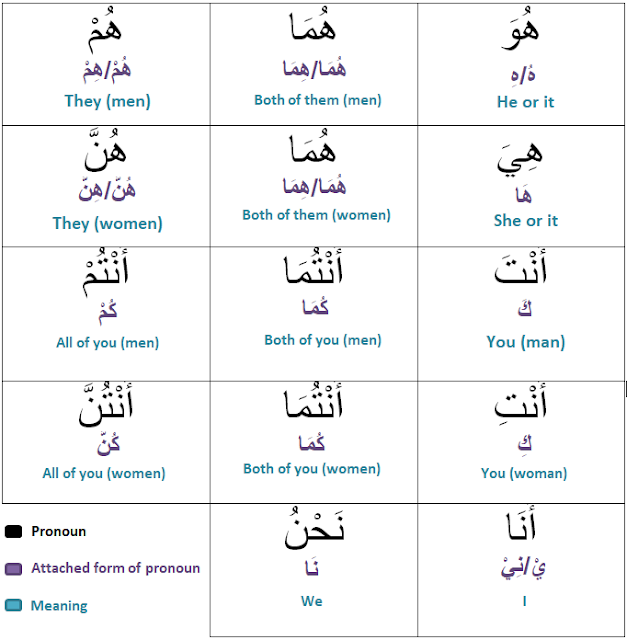Ism: Lesson 4 (Type)
Quick recap:
There are 4
properties of an ism (noun). They are:-
1. Status: rafa’
(doer), nasb (detail), jar
2. Number:
singular, pair, plural
3. Gender:
masculine, feminine
4. Type
Today we
will be learning about the simplest and the last property of an ism which is “type.”
Type
basically means whether an ism is proper (known) or common (unknown). It’s kind
of like using ‘a’ and ‘the’ in English but its more comprehensive as we will
see later In Sha Allah. Today we will just look at one way in which an ism can
be made proper. That is by adding an ‘Al’ at the beginning of an ism.
Example:
كِتَابٌ
الْكِتَابُ
A book The book
وَلَدٌ
الْوَلَدُ
A son The son
If someone
says kithaabun (a book), we don’t know which book he is talking about. But if
someone says al-kithaab (the book), the person he is talking to also knows
which book he is talking about.
Notice when
we add the ‘al’ to a singular ism, the thanween (‘n’ sound is removed). But when
it comes to plural isms, the ending sound of the word remains same. For
example:
مُؤْمِنُونَ
الْمُؤْمِنُونَ
Believers The believers
Mental
exercise:
Look at the
words below and decide whether the word is proper or common.
شَرَابٌ
الْقُرْءَانُ
اْلآيَاتِ
أُمَّةٌ
نَبَاتٍ
اْلأَمِيْن
*********************************************************
ކުރީގެ ފިލާވަޅުތަކަށް އަވަސް ނަޒަރެއް:
ކޮންމެ އިސްމް (ނަމެއް) އެއްގައި ވެސް 4 ސިފައެއްވެއެވެ. އެއީ:
މަޤާމް: ރަފަޢް (ކަންކުރާ ފަރާތް)، ނަޞްބް (ތަފްޞީލު)، ޖަރް
ޢަދަދު: މުފްރަދު (އެކެއް)، މުޘައްނާ (ދޭ)، ޖަމްޢު (ދޭކަށްވުރެ ގިނަ)
ޖިންސު: ފިރިހެން، އަންހެން
ވައްތަރު
މިއަދު އަހަރުމެން ބަލާލާނީ އިސްމްތަކުގެ އެންމެ ފަހު އަދި ނަގައިގަންނަން
އެންމެ ފަސޭހަ ސިފަ ކަމަށްވާ 'ވައްތަރު' އަށެވެ.
އިސްމްތަކުގެ ދެ ވައްތަރެއްވެއެވެ. އެއީ މަޢްރިފާ (އެނގޭ އިސްމެއް) އަދި
ނަކިރާ (ނޭނގޭ ނަމެއް) އެވެ. މިއަދު އަހަރުމެން ބަލާލާނީ އިސްމްއެއް (ނަމެއް)
މަޢްރިފާ ކުރެވިދާނެ އެއްގޮތަށެވެ. އެއީ އިސްމްއެއްގެ ކުރިއަށް 'އަލް' އިތުރު
ކޮށްގެނެވެ.
މިސާލު:
މަޢްރިފާ
ނަކިރާ
كِتَابٌ
الْكِتَابُ
ފޮތް ފޮތް
وَلَدٌ
الْوَلَدُ
ފިރިހެން ކުއްޖާ
ފިރިހެން ކުއްޖާ
މި ދެބަހުގެ މާނަވެސް އަންނާނީ ފޮތުގެ ގޮތުގައެވެ. އެހެނަސް މީހަކު 'ކިތާބުން'
އޭ ކިޔުނީމަ އެ ދައްކަނީ ސީދާ ކޮން ފޮތެއްގެ ވާހަކަކަން ނޭނގޭނެއެވެ. އަދި
'އަލްކިތާބު' އޭ ކިޔައިފިނަމަ އެ ފޮތަކީ ސީދާ ކޮން ފޮތެއްކަން އެ ވާހަކަ އަޑުއަހާ
މީހަކަށް ވެސް އެނގޭކަން ހާމަކޮށްދެއެވެ.
ހަމަ އެފަދައިން ދެން އޮތް ދެބަހުގެ މާނަވެސް އަންނާނީ ފިރިހެން ކުއްޖާގެ
ގޮތުގައެވެ. އެހެނަސް 'ވަލަދުން' އޭ ކިޔައިފިނަމަ އެއީ ސީދާ ކޮން ފިރިހެން
ކުއްޖެއްކަން ނޭނގޭނެއެވެ. އަދި 'އަލްވަލަދު' އޭ ކިޔައިފިނަމަ އެއީ ސީދާ ކޮން
ފިރިހެން ކުއްޖެއްކަން އެ ވާހަކަ އަޑުއަހާ މީހަކަށް ވެސް އެނގޭކަން
ހާމަކޮށްދެއެވެ.
އެންމެ އެއްޗެއްގެ ވާހަކަ ހާމަ ކުރާ އިސްމްތަކަށް (މުފްރަދް އިސްމްތަކަށް)
'އަލް' އިތުރުކުރުމުން އެ އިސްމްގެ ފަހަތުގައި ވާ ތަންވީން (ނޫނުގެ އަޑު) ނެތިގެން
ދާކަން ތިބާއަށް ފާހަގަވާނެއެވެ. އެހެނަސް މުޘައްނާއާއި ޖަމްޢު އިސްމްތަކަށް
'އަލް' އިތުރު ކުރުމުން އެހެން ބަދަލެއް ނާންނާނެއެވެ. މިސާލު:
مُؤْمِنُونَ
الْمُؤْمِنُونَ
މުއުމިނުން
މުއުމިނުން
ފަރިތަކުރުން:
ތިރީގައިވާ ބަސްތަކަށް ބަލާފައި އެއީ މަޢްރިފާ އިސްމްއެއްތޯ ނޫނީ ނަކިރާ
އިސްމްއެއްތޯ ބުނެދޭށެވެ.
شَرَابٌ
الْقُرْءَانُ
اْلآيَاتِ
أُمَّةٌ
نَبَاتٍ
اْلأَمِيْن


I have started learning more Arabic through this blog. I am learning from other resources too. I must say these lessons are very good and easy to understand and also Interesting!
ReplyDeleteJazaakillah Khairan ♥️♥️😊
May Allah put barakah in everything you do. Ameen. You are a blessing which makes Qur'an and Arabic more interesting!! أحبك في الله